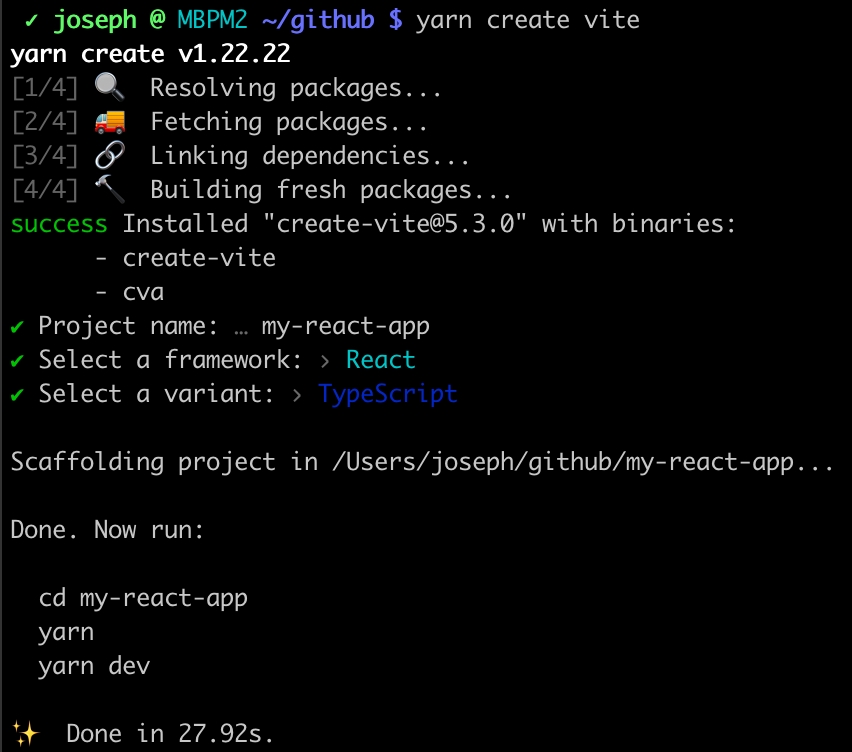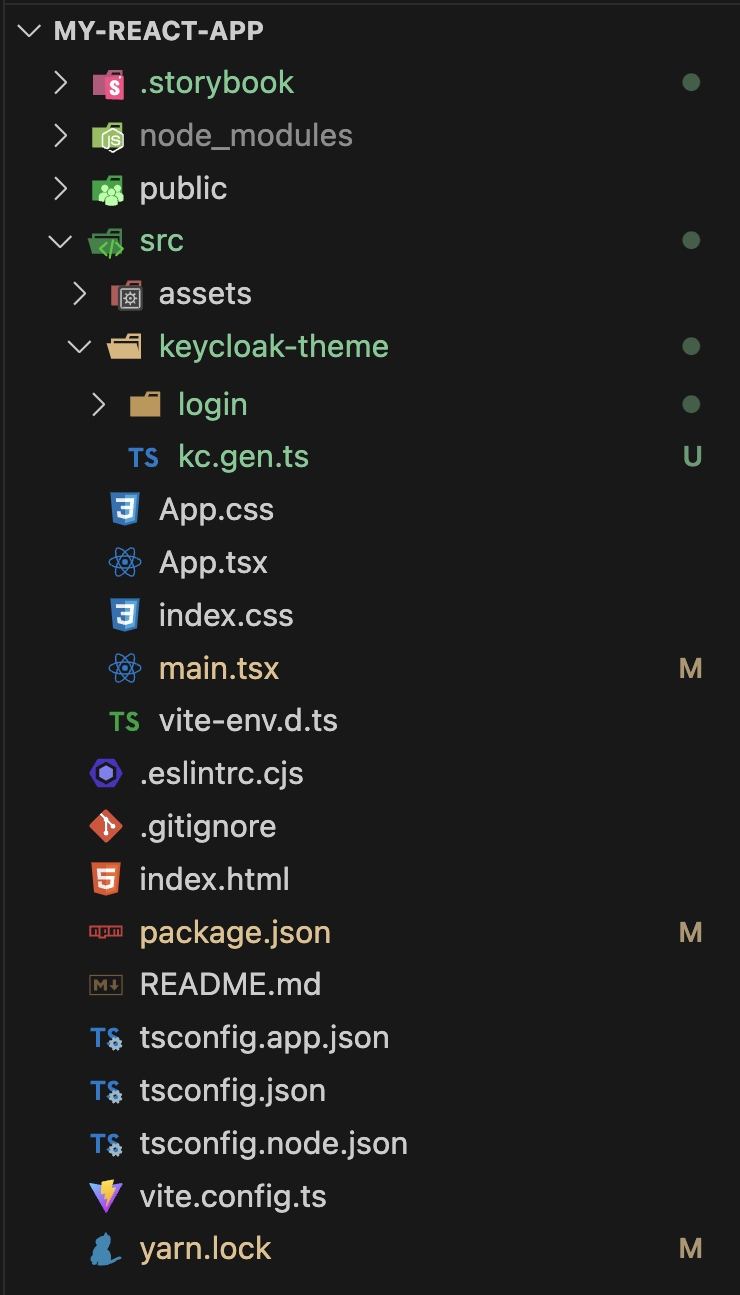In your Vite Project
If you have a Vite/React/TypeScript project you can integrate Keycloakify directly inside it.
In this guide we're going to work with a vanilla Vite project.


Let's start by installing Keycloakify (and optionally Storybook) to our project:
yarn add keycloakify
yarn add --dev storybook @storybook/react @storybook/react-vitepnpm add keycloakify
pnpm add --dev storybook @storybook/react @storybook/react-vitebun add keycloakify
bun add --dev storybook @storybook/react @storybook/react-vitenpm install --save keycloakify
npm install --save-dev storybook @storybook/react @storybook/react-viteNext we want to repatriate the relevant files from the starter template into our project:
cd my-react-app
git clone https://github.com/keycloakify/keycloakify-starter tmp
mv tmp/src src/keycloak-theme
mv tmp/.storybook .
rm -rf tmp
rm src/keycloak-theme/vite-env.d.ts
mv src/keycloak-theme/main.tsx src/main.tsx
Now you want to modify your entry point so that:
If the kcContext global is defined, render your Keycloakify theme
Else, reder your App as usual.
Let's say, for example, your src/main.tsx file currently looks like this:
import { StrictMode } from "react";
import { createRoot } from "react-dom/client";
import App from "./App";
import "./index.css";
import { MyProvider } from "./MyProvider";
createRoot(document.getElementById('root')!).render(
<StrictMode>
<MyProvider>
<App />
</MyProvider>
</StrictMode>,
);You want to rename this file to src/main.app.tsx (for example) and modify it as follow:
import App from "./App.tsx";
import "./index.css";
import { MyProvider } from "./MyProvider.tsx";
export default function AppEntrypoint() {
return (
<MyProvider>
<App />
</MyProvider>
)
}Then you want to create the following src/main.tsx file, you can copy paste the following code, it does not need to be adapted:
import { createRoot } from "react-dom/client";
import { StrictMode, lazy, Suspense } from "react";
import { KcPage, type KcContext } from "./keycloak-theme/kc.gen";
const AppEntrypoint = lazy(() => import("./main.app"));
// The following block can be uncommented to test a specific page with `yarn dev`
// Don't forget to comment back or your bundle size will increase
/*
import { getKcContextMock } from "./keycloak-theme/login/KcPageStory";
if (import.meta.env.DEV) {
window.kcContext = getKcContextMock({
pageId: "register.ftl",
overrides: {}
});
}
*/
createRoot(document.getElementById("root")!).render(
<StrictMode>
{window.kcContext ? (
<KcPage kcContext={window.kcContext} />
) : (
<Suspense>
<AppEntrypoint />
</Suspense>
)}
</StrictMode>
);
declare global {
interface Window {
kcContext?: KcContext;
}
}You also need to use Keycloakify's Vite plugin. Here we don't provide any build options but you probably at least want to define keycloakVersionTargets.
import { defineConfig } from 'vite'
import react from '@vitejs/plugin-react'
import { keycloakify } from "keycloakify/vite-plugin";
// https://vitejs.dev/config/
export default defineConfig({
plugins: [
react(),
keycloakify({
accountThemeImplementation: "none"
})
],
})Finally you want to add to your package.json a script for building the theme and another one to start storybook.
{
"name": "my-react-app",
"type": "module",
"scripts": {
"dev": "vite",
"build": "tsc -b && vite build",
"lint": "eslint . --ext ts,tsx --report-unused-disable-directives --max-warnings 0",
"preview": "vite preview",
"build-keycloak-theme": "npm run build && keycloakify build",
"storybook": "storybook dev -p 6006"
},
// ...Last step is to exclude from your html <head /> things that aren't relevant in the context of Keycloak pages.
Do not blindly copy paste, this is just an example!
You have to figure out what does and does not make sense to be in the <head/> of your Keycloak UI pages.
<!doctype html>
<html>
<head>
<meta charset="UTF-8" />
<link rel="icon" type="image/svg+xml" href="/vite.svg" />
<meta name="viewport" content="width=device-width, initial-scale=1.0" />
<meta name="keycloakify-ignore-start">
<title>ACME Dashboard</title>
<script>
window.ENV = {
API_ADDRESS: '${API_ADDRESS}',
SENTRY_DSN: '${SENTRY_DSN}'
};
</script>
<meta name="keycloakify-ignore-end">
<!-- ... -->
</head>
<!-- ... -->In the above example we tell keycloakify not to include the <title> because keycloakify will set it dynamically to something like "ACME- Login" or "ACME - Register".
We also exclude a placeholder script for injecting environment variables at container startup.
That's it, your project is ready to go! 🎉
You can run npm run build-keycloak-theme, the JAR distribution of your Keycloak theme will be generated in dist_keycloak.
You're now able to use all the Keycloakify commands (npx keycloakify --help) from the root of your project.
If you're currently using keycloak-js or react-oidc-context to manage user authentication in your app you might want to checkout oidc-spa, the alternative from the Keycloakify team.
If you have any issues reach out on Discord! We're here to help!
Last updated
Was this helpful?